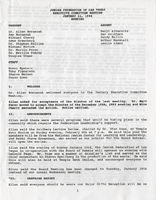Search the Special Collections and Archives Portal
Search Results
Willard H. George Furrier, Ltd. Scrapbooks
Identifier
Abstract
The Willard H. George Furrier, Ltd. Scrapbooks are comprised primarily of three leatherbound scrapbooks containing black-and-white and sepia toned photographs taken from the 1920s through 1955. The scrapbooks feature actresses from Hollywood, California wearing furs designed and created by furrier Willard H. George. Actresses of note include Lucille Ball, Rita Hayworth, and Greta Garbo.
Archival Collection
Corbin Harney Nevada Test Site Protest Photograph Albums
Identifier
Abstract
The Corbin Harney Nevada Test Site Protest Photograph Albums (1995-1997) are comprised of three photograph albums documenting the life and spiritual, environmental, and political activism work of Corbin Harney, elder and spiritual leader of the Newe ("the People") Western Shoshoni Indians. The majority of the photographs are focused on the anti-nuclear protest demonstrations by the Shundahai Network at the Nevada Test Site during the 1990s.
Archival Collection
Rancho High School Class of 1962 Collection
Identifier
Abstract
The Rancho High School Class of 1962 Collection (1956-2017) consists of materials donated by students of Rancho High School in Las Vegas, Nevada. The collection contains school event clippings, newspaper clippings, scrapbooks, pamphlets, physical and digital photographs, and school jackets and sweaters. Additionally, the collection chronicles the lives of many students after graduation through school reunion documentation from the 1970s to 2017. The collection also includes planning files for class reunion celebrations including the 40th, 50th, and 55th reunions.
Archival Collection
Morton "Mort" Saiger Portraits and News Articles
Identifier
Abstract
The Morton "Mort" Saiger Portraits and News Articles (1960-1987) consists of four newspaper and journal articles about Saiger and the Last Frontier Hotel Casino, two professional photographic portraits of Saiger, and a presentation plaque from the International Golf Club.
Archival Collection
Southern Nevada Historical Society Records
Identifier
Abstract
The Southern Nevada Historical Society Records document the management and development of the Southern Nevada Historical Society (SNHS) as well as various historical projects in Las Vegas and Southern Nevada that the society sponsored from 1948 to 1983. The records include SNHS correspondence (1951-1978), meeting minutes (1958-1983), and accounting information (1959-1980). It also contains copies of the SNHS Backtrails Newsletter, promotional material for events, membership lists, and research materials for various projects related to the history of southern Nevada and Las Vegas.
Archival Collection
Cork Proctor Photograph Collection
Identifier
Abstract
The Cork Proctor Photograph Collection (1960s-1980s) primarily contains black-and-white photographic reproductions of early Las Vegas, Nevada; the Cal-Neva Lodge at Lake Tahoe, Nevada; and various celebrities. The collection also includes black-and-white photographic prints of the Helldorado Parade. Cork Proctor was a comedian who performed throughout Nevada and the United States.
Archival Collection

Transcript of interview with Sandra Peña by Lada Mead and Stefani Evans, March 27, 2017
Date
Archival Collection
Description
Sandra Peña’s story begins in East Los Angeles, where she spent her first fifteen years with her parents (both from Michoacán, Mexico), and her younger sister. The father's managerial position at Master Products allowed the family to live rent-free in a company-owned house behind the main factory, because he collected the rents for the company's two other dwellings. In this interview, Peña recalls the family move to Porterville, in California's Central Valley, her return to Los Angeles at nineteen, and her work with Parson’s Dillingham, a contractor for the Metrolink rail system. She draws the link between the Los Angeles and Las Vegas construction communities by describing her husband's move to Las Vegas to find work; a chance Las Vegas encounter with a friend from Chino, California; her ability to gain employment in Las Vegas at Parson’s, a company that had joint ventured with Parson’s Dillingham, and her move from there to Richardson Construction, a local minority-owned company. As Peña says, "It's kind of all intermingled. Even if you go here and you go there, it's like everybody knows everybody." Throughout, Peña weaves her family story into the narrative as she describes her youth, the birth of her son, the illness and death of her father, and her family's participation in her current employment with Richardson. As she remembers the people, places, and events of her life, Peña speaks to the ways one woman of color built on her interstate construction connections and rose in a male-dominated industry.
Text

Transcript of interview with Joy Snyder by Lisa Gioia-Acres, December 17, 2009
Date
Archival Collection
Description
Joy Snyder, born and raised in Pennsylvania, is the daughter of Jean Dasinto and stepdaughter of Ray Hunt. Though she was raised thinking she was an only child, she shares that as an adult, she was contacted by an aunt who gave her information about an Austrian half-sister. The half-sister had tracked the family through WWII records on her biological father! Joy was raised in a very large extended Italian family (her maternal grandmother was first-generation Italian) and became the first in her family to attend college. She had decided early on that she wanted to be a nurse and chose to attend Temple University Hospital in Philadelphia. She recounts memories of her earliest work there, which began the first week of school. After graduation from nursing school, Joy married her childhood sweetheart, William (Bill) Snyder. They made the move to Las Vegas in 1978 and Joy found work right away at Desert Springs Hospital. She worked there about six months and then took maternity leave after the birth of their second son. When she returned to work, it was at Sunrise Hospital (early 1979) in the newborn nursery. Joy comments on many aspects of her career, including the informal approach to health care, the effects of desert climate on mothers and newborns, and the changes she has seen at Sunrise Hospital. She also comments on adoption practices in Las Vegas, drug-addicted babies, and cultural attitudes that appear during the birthing process. Today Joy is retired and her husband Bill is close to retiring. They feel a strong connection to Las Vegas (Bill has a school named after him), but maintain a second home in New York for their trips back East to visit friends and family. They also keep up with various community activities, including book clubs and running clubs for the children at William Snyder Elementary School.
Text


